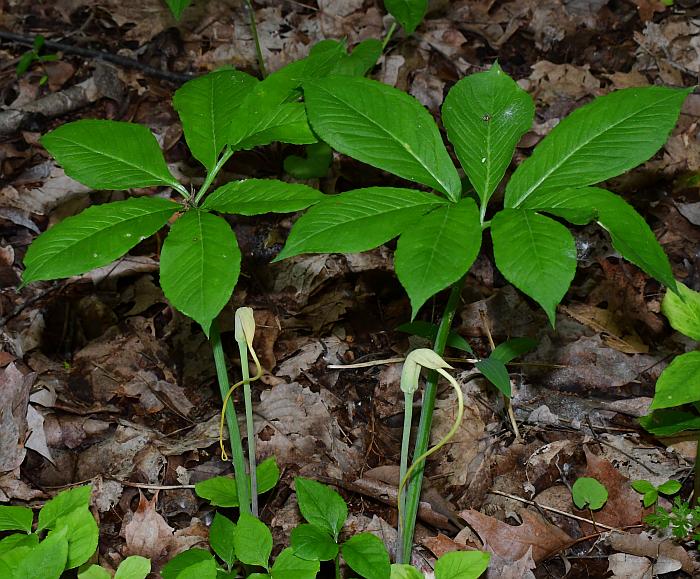Arisaema dracontium (L.) Schott

Native
CC = 6
CW = -3
MOC = 63
© SRTurner
Arisaema dracontium (L.) Schott | |
 |
Native CC = 6 CW = -3 MOC = 63 |
© SRTurner |
|
Family - Araceae Habit - Perennial monoecious forb, from a corm. Leaves - Usually solitary, to 1 m long, continuing to enlarge during growing season, the petiole stout, glabrous, and glaucous, the base sheathing. Leaflets 5-15, the largest leaflets to 25 cm long, elliptic to oblanceolate, attenuate.
Inflorescences - Solitary and terminal, the peduncle shorter than the leaf petiole. consisting of a dense spike (spadix) partially surrounded by a large, sheathing bract (spathe). Spathes 3-6 cm long, green, with a sharp bend toward the middle, the tip acute, tightly encircling the spadix. Spadices with an arched, long-tapered sterile tip extending up to 10 cm beyond the spathe. Spadices with upper band of staminate flowers and lower band of pistillate flowers.
Flowers - Tiny, densely arranged on spadix. Perianth none. Staminate flowers with 2-6 stamens, the filaments very short. Pistillate flowers with 1 superior ovary, more or less embedded in the spadix. Ovaries with 1 to several ovules. Styles none or very short.
Fruits - Dense cylindric to subglobose cluster of berries, these bright red, 1.0-1.3 cm in diameter, with 1-3 seeds.
Flowering - April - June. Habitat - Bottomland and mesic forests. Origin - Native to the U.S. Lookalikes - None. Other info. - This well-known species is closely related to Jack-in-the-pulpit, and has a very similar inflorescence structure. It is found across Missouri, and ranges across the eastern half of the continental U.S. and into Canada. The plant is easily recognized, even when not in flower, by the distinctive shape of the leaves. In fact, the leaves are usually the part of the plant which is first seen and recognized, since the inflorescences are relatively inconspicuous. The compound leaf blades are bilaterally symmetrical, with each half typically consisting of 2-4 leaflets attached by thick stalks. The images above convey this better than words. Photographs taken at Weldon Spring Conservation Area, St. Charles County, MO, 5-11-2010, along the Katy Trail near Treloar, Warren County, MO, 5-2-2020 and 7-16-2020, near Labadie, Franklin County, MO, 5-3-2020 and 5-19-2020, and along the Katy Trail near Dutzow, Warren County, MO, 8-26-2021 (SRTurner). |